to protect the environment and natural resources through green growth and sustainable ways
This is a success story about promoting community participation in the sustainable management and use of natural resources, whether it is defining the boundaries of protected forests and village reserves, creating regulations, creating monitoring groups, etc. It has provided knowledge about disaster preparedness, promoted the production of more energy-efficient stoves to reduce fuel consumption and help solve climate change problems. Here are some outstanding stories that show the success of some projects. We invite you to read and follow along:
Siphon’s commitment to the conservation of natural resources
Laos has a wealth of natural resources, such as rice, fish, and various terrestrial and aquatic resources, especially forest products, which are distributed across different provinces and provide habitats for wildlife and livelihoods for villagers. However, due to population growth and resource depletion, many stakeholders are concerned and have implemented measures to ensure more sustainable management. One example is the Programme to promote the establishment of protected areas and the sustainable use of natural resources (NTFP), which supports and empowers the target group to participate in the conservation and management of forests in a sustainable manner. Mrs. Khamdaphon Vilalery, 30 years old, from Daktaocnoy Village, DakChueng District, Sekong Province, is one of the beneficiaries of this programme. She has a family of five: herself, her husband who is a soldier, and three children. She engages in farming, gardening, and taking care of her family and children. She also serves on the committee of the management unit of the conservation area and the utilization area of forest products in her village.
I am a representative of the villagers who went to learn from other places. I feel proud and happy to have the opportunity to acquire many skills, such as planting bamboo, galangal, rattan, and beekeeping, until I have the knowledge and the idea to contribute to the conservation of the village’s natural resources. I also demonstrated the techniques of how to make natural honey bee hives for families who are interested in raising bees through face-to-face interactions.
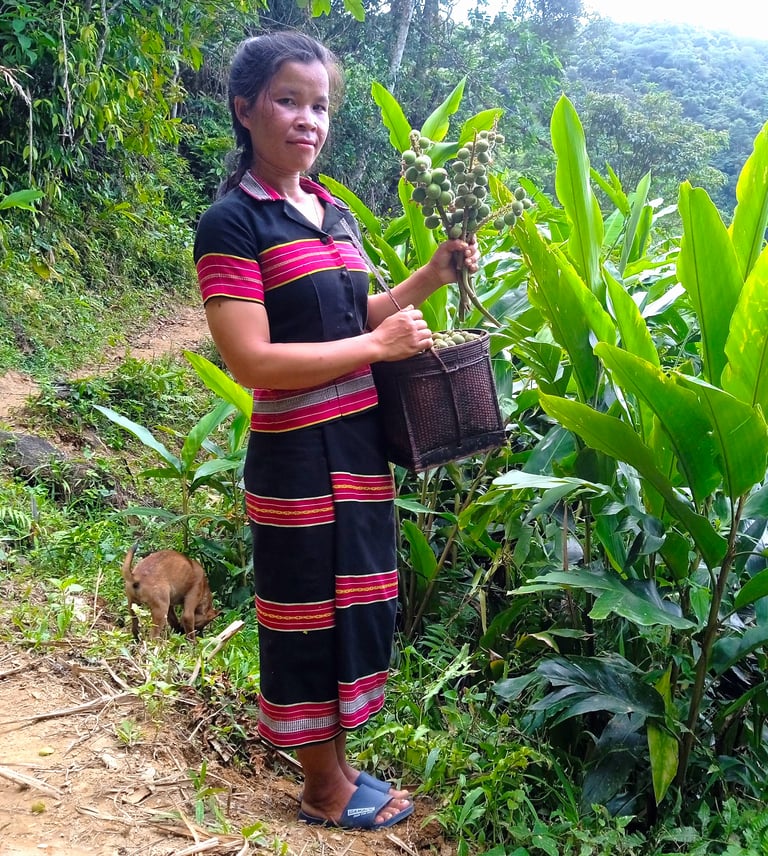

Previously, in their community, almost 95% of the people relied on nature for their livelihoods, such as: farming, gardening, obtaining food from nature, and using forest products. Many families practiced shifting cultivation, changing their plots frequently and not considering the damage or effects of natural disasters. After the project came to raise awareness about the importance of natural resources and the impact of unsustainable agricultural practices on the community’s livelihoods, they gradually changed their behavior from shifting cultivation to choosing a fixed location for farming and gardening, collecting forest products in a careful manner, and avoiding encroaching or entering the village’s nature conservation area. Mrs. Khamdaphon is also a member of the management committee of the village’s reserve area. She has participated in training on various topics, such as: natural resource management, good leadership, and best practices for planting and conserving forest products both within and outside the province. After returning from the training, she convened the villagers and discussed a plan to form a group to conserve the forest in the village, because the forest was naturally regenerated. Therefore, Mrs. Khamdaphon persuaded seven families of the village to join her in conserving the galangal (Alpinia macrostaminodia Chaveer) in an area of about 1.87 hectares.


Siphon’s commitment to the conservation of natural resources
Mr. Siphon is a 31-year-old farmer and gardener who lives with his wife, parents, and one younger brother in DakXiengAh Village, DakChueng District, Sekong Province. Like other families in that area, they depend almost entirely on nature. Some families practice shifting cultivation and clear the forest for their crops. They also rely on the forest for food, whether it is collecting forest products, hunting wild animals for consumption and sale, or building their houses with wood from the forest. The community did not have the idea of conserving and managing the forest for sustainability before.
Following the community access project, we also provided knowledge and awareness on the importance of natural resources, the impact of improper agricultural practices on the community’s livelihood and climate change, and the sustainable use and protection of forest products. We conducted training sessions on various topics such as natural resource management, good leadership, and gender roles. Moreover, we supported the community’s efforts to protect and manage natural resources by facilitating their establishment of the boundaries and rules of the protected area. DakXiengAh village has one forest reserve of 482 hectares, one forest for use of 628 hectares, and one palace of 2.5 hectares. We also facilitated the formation of a 16-member village reserve management committee and provided them with 16 sets of patrol equipment.
I am a member of the village forest management and supervision committee, and I am responsible for patrolling the natural resources management unit of the village. I feel proud and grateful that the project values the community. It gave me the opportunity to participate in many trainings organized by the project, which enhanced my understanding of my work. After attending the lesson exchange with other villages, I also shared and transferred the lessons to the people in the village for their mutual understanding. For example, I met with village organizations and villagers, presented lessons, and read the handbook on forest management rules together. I hope that we will cooperate to protect the village, conserve the forest, and maintain the abundance of natural resources for future generations.

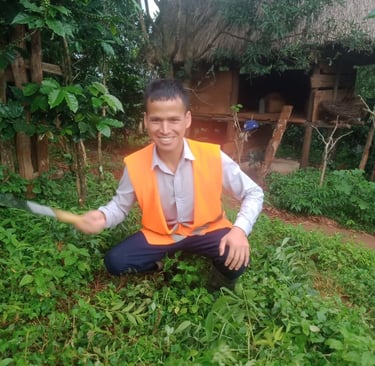
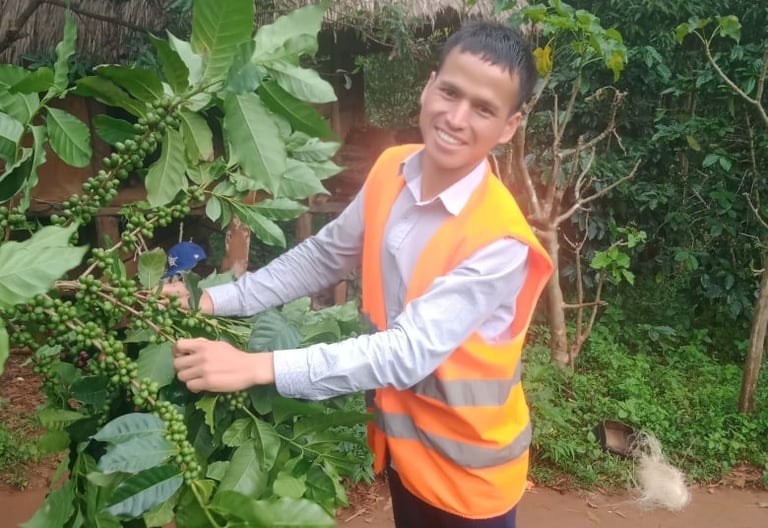

Siphon’s commitment to the conservation of natural resources
Mr. Siphon is a 31-year-old farmer and gardener who lives with his wife, parents, and one younger brother in DakXiengAh Village, DakChueng District, Sekong Province. Like other families in that area, they depend almost entirely on nature. Some families practice shifting cultivation and clear the forest for their crops. They also rely on the forest for food, whether it is collecting forest products, hunting wild animals for consumption and sale, or building their houses with wood from the forest. The community did not have the idea of conserving and managing the forest for sustainability before.
Following the community access project, we also provided knowledge and awareness on the importance of natural resources, the impact of improper agricultural practices on the community’s livelihood and climate change, and the sustainable use and protection of forest products. We conducted training sessions on various topics such as natural resource management, good leadership, and gender roles. Moreover, we supported the community’s efforts to protect and manage natural resources by facilitating their establishment of the boundaries and rules of the protected area. DakXiengAh village has one forest reserve of 482 hectares, one forest for use of 628 hectares, and one palace of 2.5 hectares. We also facilitated the formation of a 16-member village reserve management committee and provided them with 16 sets of patrol equipment.
I am a member of the village forest management and supervision committee, and I am responsible for patrolling the natural resources management unit of the village. I feel proud and grateful that the project values the community. It gave me the opportunity to participate in many trainings organized by the project, which enhanced my understanding of my work. After attending the lesson exchange with other villages, I also shared and transferred the lessons to the people in the village for their mutual understanding. For example, I met with village organizations and villagers, presented lessons, and read the handbook on forest management rules together. I hope that we will cooperate to protect the village, conserve the forest, and maintain the abundance of natural resources for future generations.




The role of conservation in Dak Yarang Village
Mr. Ngerng, 37, a resident of Dak Yang Village, Dak Cheung District, Sekong Province, Laos, is a member of the village nature reserve management committee. He said: “I am very happy that the project has come to help and promote the management of the village nature reserve and nature reserve. I have learned a lot from the project, such as community participation, good governance, gender equality, and the importance of sustainably protecting natural resources.”
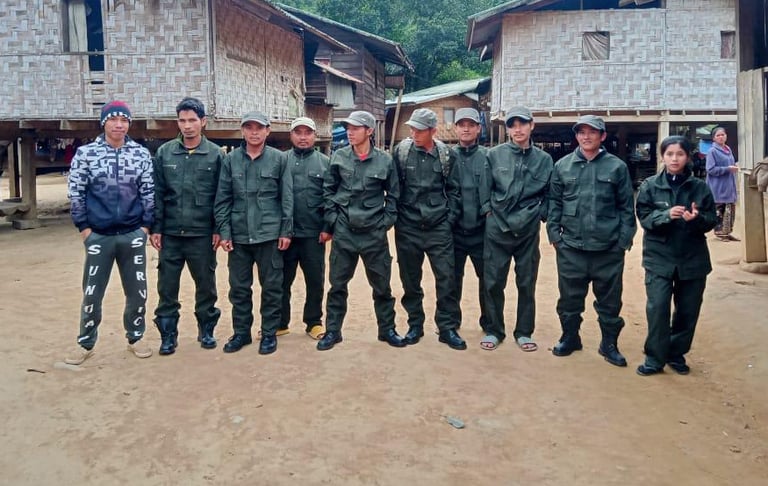

It is inevitable that people have always been closely connected to natural resources and the environment, whether as part of nature or as users of nature to be able to continue living, but few people, after using the benefits, will protect or replace what they have used so that nature will be abundant and sustainable. However, there are quite a few people who think and help to conserve natural resources. For example, the following village will be mentioned: Dak Yarang Village, located in the north of Dak Cheung District, Sekong Province, with a total area of 6,743 square meters, with a total population of 23 families, which is the target village of the project that supports and encourages the community to participate in the conservation of natural resources for sustainability. Dak Yarang Village is rich in natural resources, especially with lush green forests all year round, clean water sources and many aquatic animals, allowing the community to rely on food and sell non-timber forest products from nature to make a living. Before the project came, it was found that the village did not designate a protected area and fishing was unrestricted or other villages could come to catch it in every season, causing the previously abundant fish to gradually decrease. Currently, some species of fish are on the verge of extinction, such as crocodile fish, humpback fish, koh fish, pha fish and others. This problem has not been officially resolved, such as the creation of protected areas, the establishment of regulations and fines for offenders. In the past, village organizations have implemented and solved this problem by monitoring and collecting data on villages that often come to fish and throw bombs, and also reported it to relevant village, group and district organizations. However, no fines were imposed on offenders, only scolding, which often led to incidents of outsiders invading the protected area. After the project came to promote and support the village, it built the capacity and initiative for community conservation, improved leadership skills, led the organization of the campaign to establish the protected area and appointed a responsible committee, established regulations approved by the mayor of Dak Cheung with unanimous agreement from the villagers in the village and neighboring villages to serve as a reference for future implementation, and led the people to put up signs prohibiting fishing in the area around the protected area. The village has now changed for the better, with more villagers helping to take care of and protect the protected area.


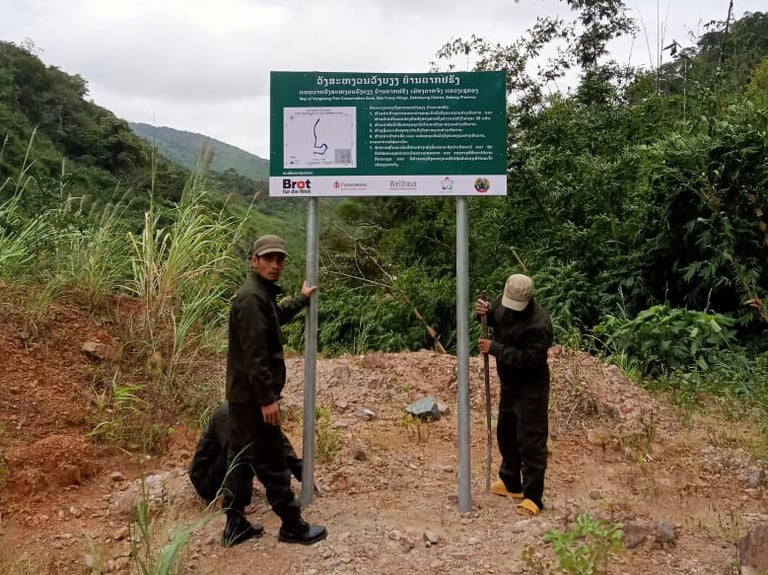

Vilay Road
House 046/05
Sounantha Village, Kayson city, Savannakhet province
Tel/Fax: 041-252717
E-mail: info@armi.la


